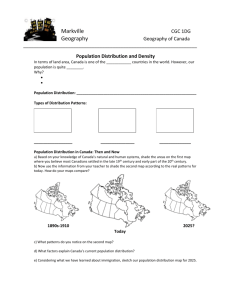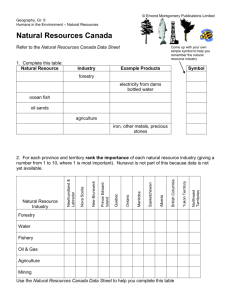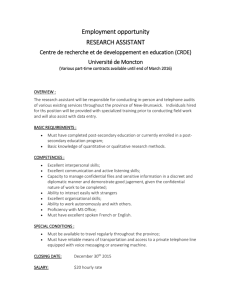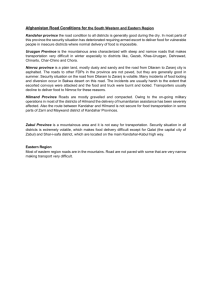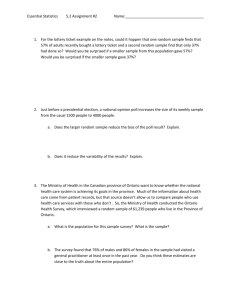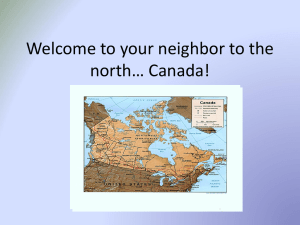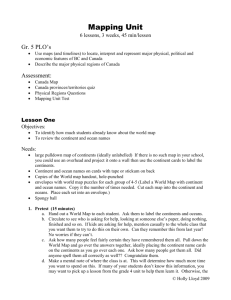Socials-Grade-5-Projects
advertisement
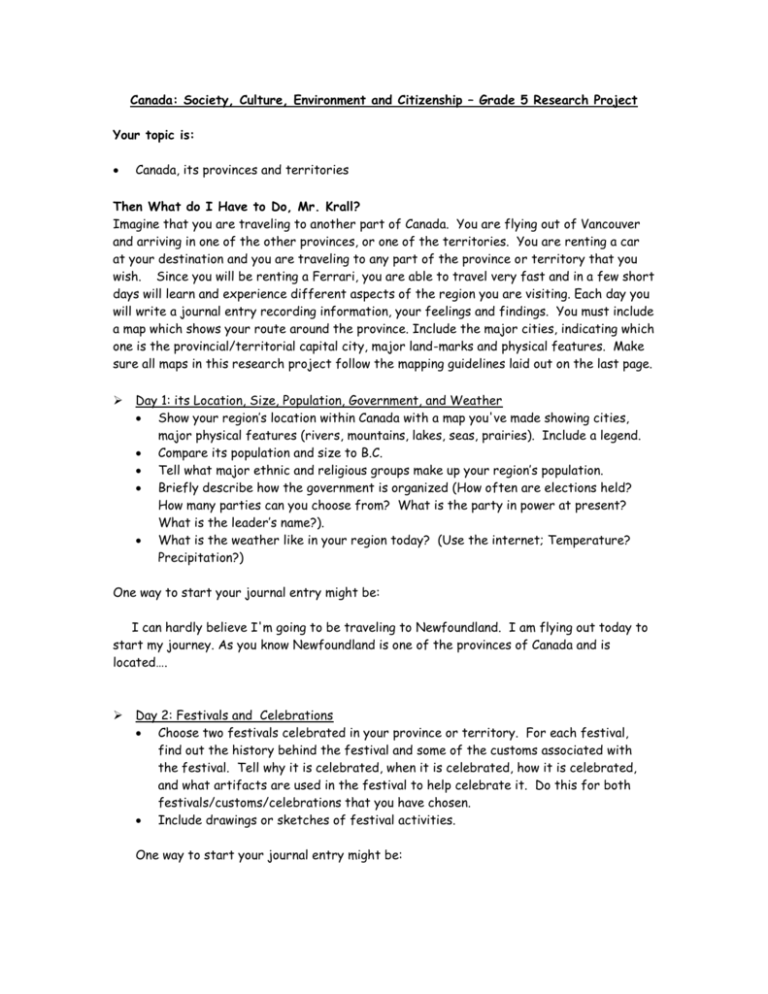
Canada: Society, Culture, Environment and Citizenship – Grade 5 Research Project Your topic is: Canada, its provinces and territories Then What do I Have to Do, Mr. Krall? Imagine that you are traveling to another part of Canada. You are flying out of Vancouver and arriving in one of the other provinces, or one of the territories. You are renting a car at your destination and you are traveling to any part of the province or territory that you wish. Since you will be renting a Ferrari, you are able to travel very fast and in a few short days will learn and experience different aspects of the region you are visiting. Each day you will write a journal entry recording information, your feelings and findings. You must include a map which shows your route around the province. Include the major cities, indicating which one is the provincial/territorial capital city, major land-marks and physical features. Make sure all maps in this research project follow the mapping guidelines laid out on the last page. Day 1: its Location, Size, Population, Government, and Weather Show your region’s location within Canada with a map you've made showing cities, major physical features (rivers, mountains, lakes, seas, prairies). Include a legend. Compare its population and size to B.C. Tell what major ethnic and religious groups make up your region’s population. Briefly describe how the government is organized (How often are elections held? How many parties can you choose from? What is the party in power at present? What is the leader’s name?). What is the weather like in your region today? (Use the internet; Temperature? Precipitation?) One way to start your journal entry might be: I can hardly believe I'm going to be traveling to Newfoundland. I am flying out today to start my journey. As you know Newfoundland is one of the provinces of Canada and is located…. Day 2: Festivals and Celebrations Choose two festivals celebrated in your province or territory. For each festival, find out the history behind the festival and some of the customs associated with the festival. Tell why it is celebrated, when it is celebrated, how it is celebrated, and what artifacts are used in the festival to help celebrate it. Do this for both festivals/customs/celebrations that you have chosen. Include drawings or sketches of festival activities. One way to start your journal entry might be: Today I had a chance to take part in one of the many festivals that are celebrated in Prince Edward Island. There are many different festivals . . . . Day 3: Sports and Recreation In your province or territory, find out about traditional (not foreign or popular sports) sports in that province. Choose one traditional sport and describe its history, rules, equipment needed and culture. Imagine you were a spectator and tell what you saw. Find out about popular recreational past-times in your province or territory. Choose one hobby/past-time/amusement and describe its history, rules (if any) and culture. Imagine you were a spectator and tell what you saw. One way to start your journal entry might be: I now understand why curling is so popular in Saskatchewan. It was very interesting to watch the rules and etiquette that surround this sport. Day 4: Historic Landmarks Your province or territory has many historic landmarks. Today you traveled to a historic landmark and while you were there the director asked you for help in designing a new brochure for tourists. Design your brochure and include a copy in your report. Include a map of where it's located and how to get there; drawings/diagrams showing various parts; historical facts; explanation of it historical importance - design it to attract tourists such as yourself! Include information about other landmarks and historical places that may be related. One way to begin your journal entry might be: Today I traveled with my host family to visit the historic site of .... Day 5: Food In your next province you decided to sample some of the traditional foods of the province/territory or ethnic cultures found there. You've learned a few customs surrounding food and eating. Describe the traditional foods eaten, both on special occasions and every day. What ingredients are commonly used in many dishes? What are the flavours like. Does it remind you of food you have eaten elsewhere? What are some of the customs surrounding some of these foods? In your journal entry design a menu for a Canadian restaurant which includes some of the most popular foods. One way to start your journal entry might be: I though I might starve to death before I finally decided to eat seal, but it’s one of the most popular dishes with the Inuit. They prepare it in many different ways, and the flippers are a particular delicacy… Day 6: Art and Music In your province/territory, imagine that you have heard some traditional music from another culture that was brought to the province through Canada’s immigration policy. Imagine that you have observed many artistic talents: gardening, drama, paintings, festivals, plays and performances. In your journal you will describe what you have seen and heard and how the people reveal their beliefs through the arts. Focus on one artist/musician from your host province/territory. Write a very brief biography in your journal, including some of the major events in his/her life. Describe the person’s art and include a picture. One way to start your journal entry might be: In my short time here I have learned a lot about different Ukrainian arts. My guides in this province sing in choirs and have several musical instruments in their home . . . Day 7: The Trip’s Conclusion Your journey is coming to an end. In a few days time you will be back home eager to share what you have learned with your classmates. There is still much about your country you don't know. Today you will have an opportunity to find out just one more thing about your country. Choose from the items below and include a journal item about it. Becoming a Canadian Citizen Immigration to Canada What is Canadian Culture? One way to start your journal entry might be: It hardly seems possible that my trip is coming to an end and I will be home soon. I've learned so much, but I have lots to share. Day 8: You’re Home! Come on, be honest, you’re glad to be back. Sure your holiday was great, but there were many things about British Columbia, and home, that you missed. In your journal write down all the things that you missed about British Columbia, explaining why you missed them. Then, write about which features of the provinces/territories you would like to incorporate into British Columbia to make it just that little bit better!! One way to start your journal entry might be: I’m back! The smells, noises and tastes that I missed remind me that I belong here. Believe it or not, the rain is a refreshing change… Your Report Should Be Organized in the Following Order: Title page Map Table of Contents Introduction Journal Entries Illustrations (other maps, diagrams and pictures) Conclusion Bibliography (You must use at least): one reference book (i.e. your textbook – if you have one) one computer resource one resource book Draft - Double Spaced At least 1 page of information per journal entry (handwritten or using only 14 pt. Font – Golden Rules) Edit - use Check list. Proof Read - COPS. Final Draft: Hand written, double spaced Typed - double spaced (Mr. Nixon’s Golden Rules) Project Time Line: This time line will help you manage your time wisely throughout the project. If you work ahead of this time line, that’s great!! Don’t forget your research, project writing, and illustrations must be done at home as well as at school. Remember, work smarter, not harder!! To Do Completed by Gather Facts: Oct 17 1st Draft checked by parents/ buddy: Oct 24 Final draft Project Due: Nov 3 Your Research report will be marked out of 100 using the following criteria: Content: (30 marks) writing reflects topics. topic is well organized. information contains keys ideas, supporting details, and key words. has an introduction and a conclusion. uses sources for information as indicated in bibliography. Organization: (20 marks) facts are organized in a logical manner. research is organized with sub titles. sentence/paragraph structure is correct. has included all parts of project outline above. Presentation: (25 marks) report is double spaced and either typed or neatly handwritten. illustrations support topic. model is neatly and creatively done with appropriate labels. title page has a focal point, uses space well and reflects the topic of the research project. Mechanics: (25 marks) spelling, punctuation, capitalization, grammar is correct. Project Planning & Guidelines Planning: Select your province/territory Find all the facts and details about your countries that you need. Recording Information: Read through all of your sources and take notes on important facts and details. To help organize your reading and note taking, it might be helpful to write basic questions about your subject of your report which you would like to answer in your report. Put each of these questions at the top of a separate card or sheet of paper. Any time you find a fact that helps answer one of the your questions, write this information on the card or paper with that question. Your questions should answer Who, What, Where, When, Why, and How for each topic. Organize Your Information: Arrange the note cards in the best possible order. Outlining Your Information: On a separate piece of paper write out each heading will their facts. Main Heading: detail detail “ “ 2nd Heading: detail detail “ “ Writing the final Draft: Before you write the main part of your report, you will need to write an introductory paragraph. This paragraph should say something interesting and catchy about the topics so that readers will want to read your report. After you have written the main part or body of your report you must add a concluding summary paragraph. Try to end your report with a good last sentence which captures the essence of your report. e.g. “An erupting volcano is an awesome site; they are a reminder that nature can be both fascinating yet lethal.” Bibliography and Maps: See handouts. Internet: Try this http://www.kathimitchell.com/canada/canada.htm
